语言迁移现象研究
- 格式:doc
- 大小:59.00 KB
- 文档页数:5
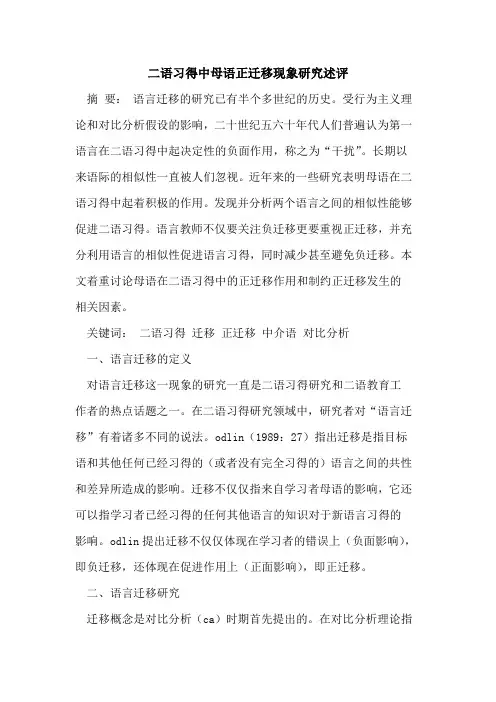
二语习得中母语正迁移现象研究述评摘要:语言迁移的研究已有半个多世纪的历史。
受行为主义理论和对比分析假设的影响,二十世纪五六十年代人们普遍认为第一语言在二语习得中起决定性的负面作用,称之为“干扰”。
长期以来语际的相似性一直被人们忽视。
近年来的一些研究表明母语在二语习得中起着积极的作用。
发现并分析两个语言之间的相似性能够促进二语习得。
语言教师不仅要关注负迁移更要重视正迁移,并充分利用语言的相似性促进语言习得,同时减少甚至避免负迁移。
本文着重讨论母语在二语习得中的正迁移作用和制约正迁移发生的相关因素。
关键词:二语习得迁移正迁移中介语对比分析一、语言迁移的定义对语言迁移这一现象的研究一直是二语习得研究和二语教育工作者的热点话题之一。
在二语习得研究领域中,研究者对“语言迁移”有着诸多不同的说法。
odlin(1989:27)指出迁移是指目标语和其他任何已经习得的(或者没有完全习得的)语言之间的共性和差异所造成的影响。
迁移不仅仅指来自学习者母语的影响,它还可以指学习者已经习得的任何其他语言的知识对于新语言习得的影响。
odlin提出迁移不仅仅体现在学习者的错误上(负面影响),即负迁移,还体现在促进作用上(正面影响),即正迁移。
二、语言迁移研究迁移概念是对比分析(ca)时期首先提出的。
在对比分析理论指导下,语言迁移现象研究的注意力集中在学习者的母语和目标语之间存在的差异上。
结构主义和行为主义的主要观点是:母语干扰第二语言的习得过程;学习者的母语干扰会引起语言错误。
当时二语习得研究者把第二语言学习中所遇到的困难都归结为母语和目标语之间的习惯差异。
lado(1957:2)认为:“如果目的语中的知识与母语相似,那么学习者学起来会感到很容易;如果与母语不同,则学起来会很困难。
”70年代,一些学者(nemser(1971),selinker(1972),corder (1978))开始把二语习得的研究重点放在学生自己产生的语言上。
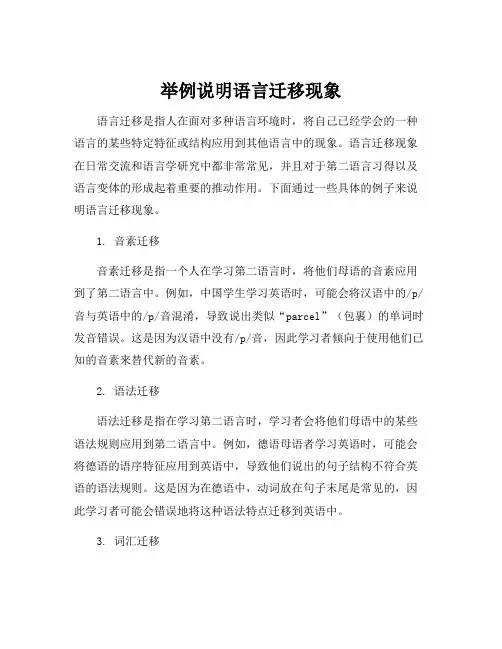
举例说明语言迁移现象语言迁移是指人在面对多种语言环境时,将自己已经学会的一种语言的某些特定特征或结构应用到其他语言中的现象。
语言迁移现象在日常交流和语言学研究中都非常常见,并且对于第二语言习得以及语言变体的形成起着重要的推动作用。
下面通过一些具体的例子来说明语言迁移现象。
1. 音素迁移音素迁移是指一个人在学习第二语言时,将他们母语的音素应用到了第二语言中。
例如,中国学生学习英语时,可能会将汉语中的/p/音与英语中的/p/音混淆,导致说出类似“parcel”(包裹)的单词时发音错误。
这是因为汉语中没有/p/音,因此学习者倾向于使用他们已知的音素来替代新的音素。
2. 语法迁移语法迁移是指在学习第二语言时,学习者会将他们母语中的某些语法规则应用到第二语言中。
例如,德语母语者学习英语时,可能会将德语的语序特征应用到英语中,导致他们说出的句子结构不符合英语的语法规则。
这是因为在德语中,动词放在句子末尾是常见的,因此学习者可能会错误地将这种语法特点迁移到英语中。
3. 词汇迁移词汇迁移是指在学习第二语言时,学习者会将他们母语中的某些词汇应用到第二语言中。
例如,法语母语者学习英语时,可能会使用法语的“déjà vu”(似曾相识)这个短语来描述英语中的类似概念。
这是因为学习者将他们熟悉的词汇转化为第二语言中类似的概念。
这些例子说明了语言迁移现象的存在及其对第二语言学习产生的影响。
语言迁移可以促进语言习得,但当迁移错误时,可能导致学习者产生语言错误或产生语言变体。
因此,在语言学习中,需要重视并纠正语言迁移现象。
教师可以通过有意识地引导学习者比较母语和目标语言的差异,帮助他们意识到并纠正迁移错误。
同时,学习者也需要通过大量的语言输入和输出来提高对语言特点的敏感度,减少语言迁移的发生。
总之,语言迁移是语言学习中常见的现象,它对于语言学习者来说是一把双刃剑。
对于教师和学习者来说,理解并准确处理语言迁移现象非常重要,以促进优质的语言习得和语言交流能力的提升。
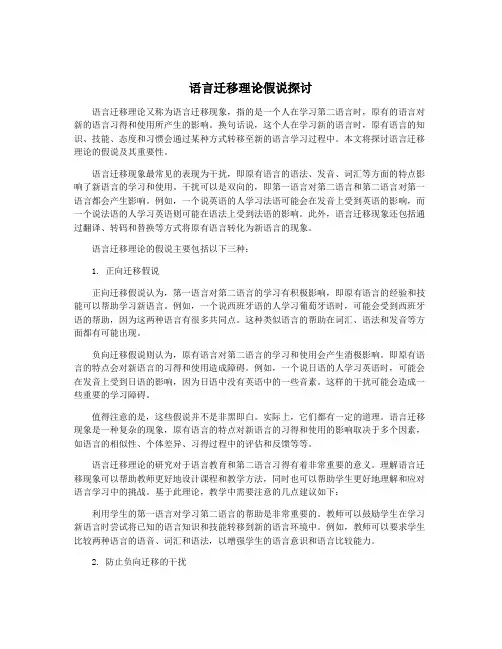
语言迁移理论假说探讨语言迁移理论又称为语言迁移现象,指的是一个人在学习第二语言时,原有的语言对新的语言习得和使用所产生的影响。
换句话说,这个人在学习新的语言时,原有语言的知识、技能、态度和习惯会通过某种方式转移至新的语言学习过程中。
本文将探讨语言迁移理论的假说及其重要性。
语言迁移现象最常见的表现为干扰,即原有语言的语法、发音、词汇等方面的特点影响了新语言的学习和使用。
干扰可以是双向的,即第一语言对第二语言和第二语言对第一语言都会产生影响。
例如,一个说英语的人学习法语可能会在发音上受到英语的影响,而一个说法语的人学习英语则可能在语法上受到法语的影响。
此外,语言迁移现象还包括通过翻译、转码和替换等方式将原有语言转化为新语言的现象。
语言迁移理论的假说主要包括以下三种:1. 正向迁移假说正向迁移假说认为,第一语言对第二语言的学习有积极影响,即原有语言的经验和技能可以帮助学习新语言。
例如,一个说西班牙语的人学习葡萄牙语时,可能会受到西班牙语的帮助,因为这两种语言有很多共同点。
这种类似语言的帮助在词汇、语法和发音等方面都有可能出现。
负向迁移假说则认为,原有语言对第二语言的学习和使用会产生消极影响。
即原有语言的特点会对新语言的习得和使用造成障碍。
例如,一个说日语的人学习英语时,可能会在发音上受到日语的影响,因为日语中没有英语中的一些音素。
这样的干扰可能会造成一些重要的学习障碍。
值得注意的是,这些假说并不是非黑即白。
实际上,它们都有一定的道理。
语言迁移现象是一种复杂的现象,原有语言的特点对新语言的习得和使用的影响取决于多个因素,如语言的相似性、个体差异、习得过程中的评估和反馈等等。
语言迁移理论的研究对于语言教育和第二语言习得有着非常重要的意义。
理解语言迁移现象可以帮助教师更好地设计课程和教学方法,同时也可以帮助学生更好地理解和应对语言学习中的挑战。
基于此理论,教学中需要注意的几点建议如下:利用学生的第一语言对学习第二语言的帮助是非常重要的。
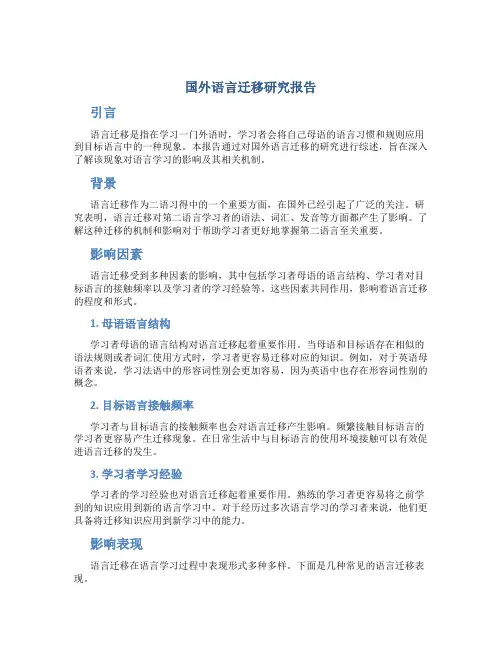
国外语言迁移研究报告引言语言迁移是指在学习一门外语时,学习者会将自己母语的语言习惯和规则应用到目标语言中的一种现象。
本报告通过对国外语言迁移的研究进行综述,旨在深入了解该现象对语言学习的影响及其相关机制。
背景语言迁移作为二语习得中的一个重要方面,在国外已经引起了广泛的关注。
研究表明,语言迁移对第二语言学习者的语法、词汇、发音等方面都产生了影响。
了解这种迁移的机制和影响对于帮助学习者更好地掌握第二语言至关重要。
影响因素语言迁移受到多种因素的影响,其中包括学习者母语的语言结构、学习者对目标语言的接触频率以及学习者的学习经验等。
这些因素共同作用,影响着语言迁移的程度和形式。
1. 母语语言结构学习者母语的语言结构对语言迁移起着重要作用。
当母语和目标语存在相似的语法规则或者词汇使用方式时,学习者更容易迁移对应的知识。
例如,对于英语母语者来说,学习法语中的形容词性别会更加容易,因为英语中也存在形容词性别的概念。
2. 目标语言接触频率学习者与目标语言的接触频率也会对语言迁移产生影响。
频繁接触目标语言的学习者更容易产生迁移现象。
在日常生活中与目标语言的使用环境接触可以有效促进语言迁移的发生。
3. 学习者学习经验学习者的学习经验也对语言迁移起着重要作用。
熟练的学习者更容易将之前学到的知识应用到新的语言学习中。
对于经历过多次语言学习的学习者来说,他们更具备将迁移知识应用到新学习中的能力。
影响表现语言迁移在语言学习过程中表现形式多种多样。
下面是几种常见的语言迁移表现。
1. 语法迁移语法迁移是指学习者将母语语法规则应用到目标语言中的现象。
例如,对于中国学生来说,英语的名词复数形式可能会受到汉语中名词没有复数形式的影响而产生错误。
2. 词汇迁移词汇迁移是指学习者将母语中的词汇应用到目标语言中。
这种迁移常常导致学习者在使用目标语言时出现词汇错误或者意思不清楚的情况。
3. 发音迁移发音迁移指的是学习者在学习目标语时,将母语的发音规则应用到目标语言中。
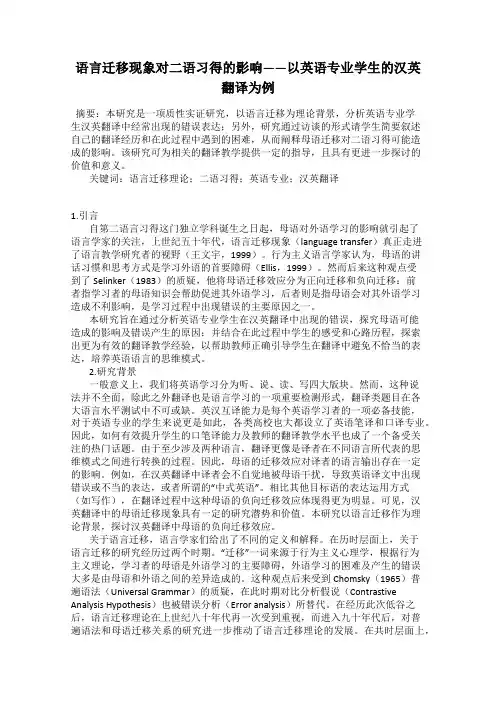
语言迁移现象对二语习得的影响——以英语专业学生的汉英翻译为例摘要:本研究是一项质性实证研究,以语言迁移为理论背景,分析英语专业学生汉英翻译中经常出现的错误表达;另外,研究通过访谈的形式请学生简要叙述自己的翻译经历和在此过程中遇到的困难,从而阐释母语迁移对二语习得可能造成的影响。
该研究可为相关的翻译教学提供一定的指导,且具有更进一步探讨的价值和意义。
关键词:语言迁移理论;二语习得;英语专业;汉英翻译1.引言自第二语言习得这门独立学科诞生之日起,母语对外语学习的影响就引起了语言学家的关注,上世纪五十年代,语言迁移现象(language transfer)真正走进了语言教学研究者的视野(王文宇,1999)。
行为主义语言学家认为,母语的讲话习惯和思考方式是学习外语的首要障碍(Ellis,1999)。
然而后来这种观点受到了Selinker(1983)的质疑,他将母语迁移效应分为正向迁移和负向迁移:前者指学习者的母语知识会帮助促进其外语学习,后者则是指母语会对其外语学习造成不利影响,是学习过程中出现错误的主要原因之一。
本研究旨在通过分析英语专业学生在汉英翻译中出现的错误,探究母语可能造成的影响及错误产生的原因;并结合在此过程中学生的感受和心路历程,探索出更为有效的翻译教学经验,以帮助教师正确引导学生在翻译中避免不恰当的表达,培养英语语言的思维模式。
2.研究背景一般意义上,我们将英语学习分为听、说、读、写四大版块。
然而,这种说法并不全面,除此之外翻译也是语言学习的一项重要检测形式,翻译类题目在各大语言水平测试中不可或缺。
英汉互译能力是每个英语学习者的一项必备技能,对于英语专业的学生来说更是如此,各类高校也大都设立了英语笔译和口译专业。
因此,如何有效提升学生的口笔译能力及教师的翻译教学水平也成了一个备受关注的热门话题。
由于至少涉及两种语言,翻译更像是译者在不同语言所代表的思维模式之间进行转换的过程。
因此,母语的迁移效应对译者的语言输出存在一定的影响。
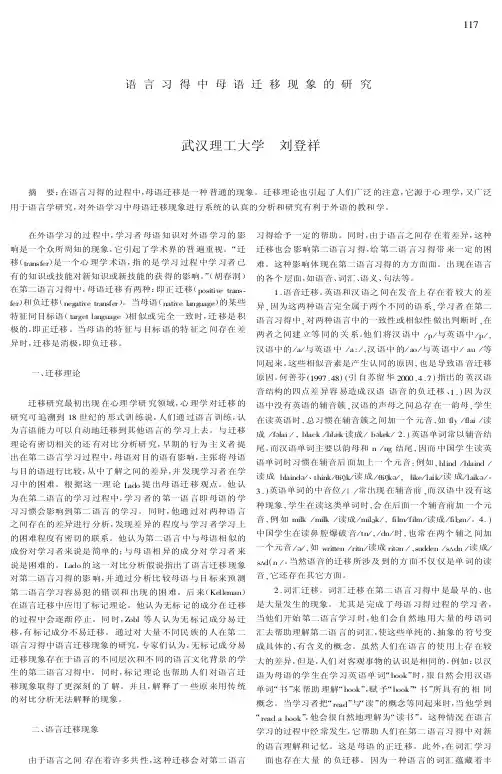
语言习得中母语迁移现象的研究武汉理工大学刘登祥摘要:在语言习得的过程中,母语迁移是一种普通的现象。
迁移理论也引起了人们广泛的注意,它源于心理学,又广泛用于语言学研究,对外语学习中母语迁移现象进行系统的认真的分析和研究有利于外语的教和学。
在外语学习的过程中,学习者母语知识对外语学习的影响是一个众所周知的现象,它引起了学术界的普遍重视。
“迁移(!"#$%&’")是一个心理学术语,指的是学习过程中学习者已有的知识或技能对新知识或新技能的获得的影响。
”(胡春洞)在第二语言习得中,母语迁移有两种:即正迁移(()%*!*+’!"#$%, &’")和负迁移($’-#!*+’!"#$%&’")。
当母语($#!*+’.#$-/#-’)的某些特征同目标语(!#"-’!.#$-/#-’)相似或完全一致时,迁移是积极的,即正迁移。
当母语的特征与目标语的特征之间存在差异时,迁移是消极,即负迁移。
一、迁移理论迁移研究最初出现在心理学研究领域,心理学对迁移的研究可追溯到01世纪的形式训练说,人们通过语言训练,认为言语能力可以自动地迁移到其他语言的学习上去。
与迁移理论有密切相关的还有对比分析研究,早期的行为主义者提出在第二语言学习过程中,母语对目的语有影响,主张将母语与目的语进行比较,从中了解之间的差异,并发现学习者在学习中的困难。
根据这一理论2#3)提出母语迁移观点。
他认为在第二语言的学习过程中,学习者的第一语言即母语的学习习惯会影响到第二语言的学习。
同时,他通过对两种语言之间存在的差异进行分析,发现差异的程度与学习者学习上的困难程度有密切的联系。
他认为第二语言中与母语相似的成份对学习者来说是简单的;与母语相异的成分对学习者来说是困难的。
2#3)的这一对比分析假说指出了语言迁移现象对第二语言习得的影响,并通过分析比较母语与目标来预测第二语言学习容易犯的错误和出现的困难。
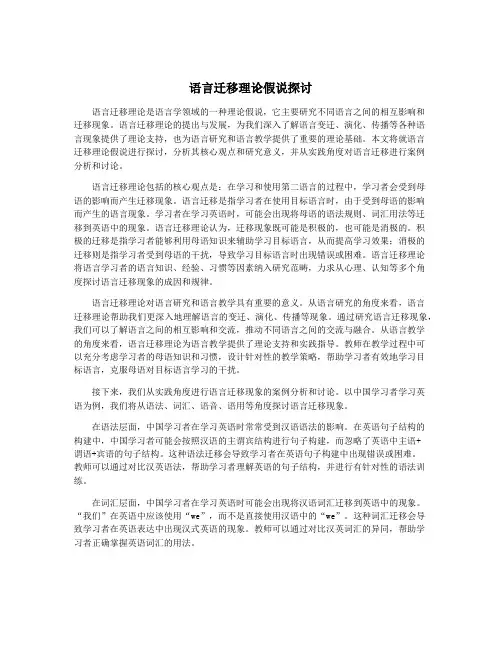
语言迁移理论假说探讨语言迁移理论是语言学领域的一种理论假说,它主要研究不同语言之间的相互影响和迁移现象。
语言迁移理论的提出与发展,为我们深入了解语言变迁、演化、传播等各种语言现象提供了理论支持,也为语言研究和语言教学提供了重要的理论基础。
本文将就语言迁移理论假说进行探讨,分析其核心观点和研究意义,并从实践角度对语言迁移进行案例分析和讨论。
语言迁移理论包括的核心观点是:在学习和使用第二语言的过程中,学习者会受到母语的影响而产生迁移现象。
语言迁移是指学习者在使用目标语言时,由于受到母语的影响而产生的语言现象。
学习者在学习英语时,可能会出现将母语的语法规则、词汇用法等迁移到英语中的现象。
语言迁移理论认为,迁移现象既可能是积极的,也可能是消极的。
积极的迁移是指学习者能够利用母语知识来辅助学习目标语言,从而提高学习效果;消极的迁移则是指学习者受到母语的干扰,导致学习目标语言时出现错误或困难。
语言迁移理论将语言学习者的语言知识、经验、习惯等因素纳入研究范畴,力求从心理、认知等多个角度探讨语言迁移现象的成因和规律。
语言迁移理论对语言研究和语言教学具有重要的意义。
从语言研究的角度来看,语言迁移理论帮助我们更深入地理解语言的变迁、演化、传播等现象。
通过研究语言迁移现象,我们可以了解语言之间的相互影响和交流,推动不同语言之间的交流与融合。
从语言教学的角度来看,语言迁移理论为语言教学提供了理论支持和实践指导。
教师在教学过程中可以充分考虑学习者的母语知识和习惯,设计针对性的教学策略,帮助学习者有效地学习目标语言,克服母语对目标语言学习的干扰。
接下来,我们从实践角度进行语言迁移现象的案例分析和讨论。
以中国学习者学习英语为例,我们将从语法、词汇、语音、语用等角度探讨语言迁移现象。
在语法层面,中国学习者在学习英语时常常受到汉语语法的影响。
在英语句子结构的构建中,中国学习者可能会按照汉语的主谓宾结构进行句子构建,而忽略了英语中主语+谓语+宾语的句子结构。
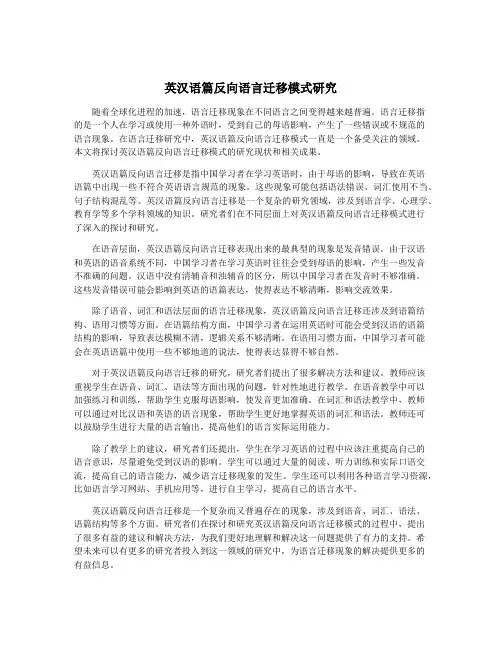
英汉语篇反向语言迁移模式研究随着全球化进程的加速,语言迁移现象在不同语言之间变得越来越普遍。
语言迁移指的是一个人在学习或使用一种外语时,受到自己的母语影响,产生了一些错误或不规范的语言现象。
在语言迁移研究中,英汉语篇反向语言迁移模式一直是一个备受关注的领域。
本文将探讨英汉语篇反向语言迁移模式的研究现状和相关成果。
英汉语篇反向语言迁移是指中国学习者在学习英语时,由于母语的影响,导致在英语语篇中出现一些不符合英语语言规范的现象。
这些现象可能包括语法错误、词汇使用不当、句子结构混乱等。
英汉语篇反向语言迁移是一个复杂的研究领域,涉及到语言学、心理学、教育学等多个学科领域的知识。
研究者们在不同层面上对英汉语篇反向语言迁移模式进行了深入的探讨和研究。
在语音层面,英汉语篇反向语言迁移表现出来的最典型的现象是发音错误。
由于汉语和英语的语音系统不同,中国学习者在学习英语时往往会受到母语的影响,产生一些发音不准确的问题。
汉语中没有清辅音和浊辅音的区分,所以中国学习者在发音时不够准确。
这些发音错误可能会影响到英语的语篇表达,使得表达不够清晰,影响交流效果。
除了语音、词汇和语法层面的语言迁移现象,英汉语篇反向语言迁移还涉及到语篇结构、语用习惯等方面。
在语篇结构方面,中国学习者在运用英语时可能会受到汉语的语篇结构的影响,导致表达模糊不清,逻辑关系不够清晰。
在语用习惯方面,中国学习者可能会在英语语篇中使用一些不够地道的说法,使得表达显得不够自然。
对于英汉语篇反向语言迁移的研究,研究者们提出了很多解决方法和建议。
教师应该重视学生在语音、词汇、语法等方面出现的问题,针对性地进行教学。
在语音教学中可以加强练习和训练,帮助学生克服母语影响,使发音更加准确。
在词汇和语法教学中,教师可以通过对比汉语和英语的语言现象,帮助学生更好地掌握英语的词汇和语法。
教师还可以鼓励学生进行大量的语言输出,提高他们的语言实际运用能力。
除了教学上的建议,研究者们还提出,学生在学习英语的过程中应该注重提高自己的语言意识,尽量避免受到汉语的影响。
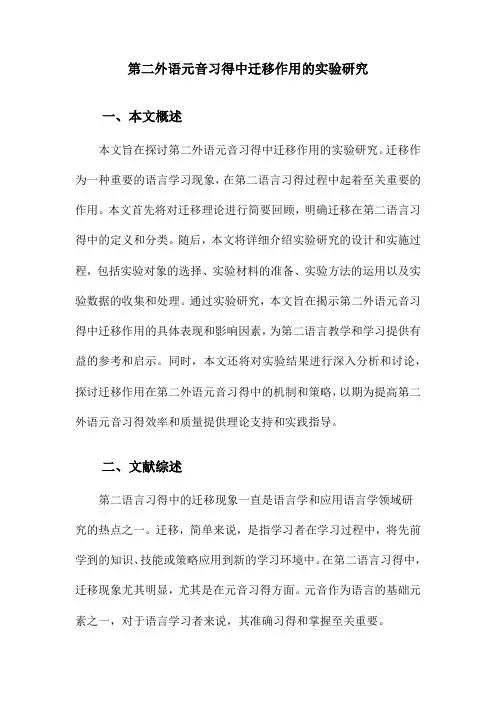
第二外语元音习得中迁移作用的实验研究一、本文概述本文旨在探讨第二外语元音习得中迁移作用的实验研究。
迁移作为一种重要的语言学习现象,在第二语言习得过程中起着至关重要的作用。
本文首先将对迁移理论进行简要回顾,明确迁移在第二语言习得中的定义和分类。
随后,本文将详细介绍实验研究的设计和实施过程,包括实验对象的选择、实验材料的准备、实验方法的运用以及实验数据的收集和处理。
通过实验研究,本文旨在揭示第二外语元音习得中迁移作用的具体表现和影响因素,为第二语言教学和学习提供有益的参考和启示。
同时,本文还将对实验结果进行深入分析和讨论,探讨迁移作用在第二外语元音习得中的机制和策略,以期为提高第二外语元音习得效率和质量提供理论支持和实践指导。
二、文献综述第二语言习得中的迁移现象一直是语言学和应用语言学领域研究的热点之一。
迁移,简单来说,是指学习者在学习过程中,将先前学到的知识、技能或策略应用到新的学习环境中。
在第二语言习得中,迁移现象尤其明显,尤其是在元音习得方面。
元音作为语言的基础元素之一,对于语言学习者来说,其准确习得和掌握至关重要。
近年来,国内外学者对第二外语元音习得中的迁移作用进行了广泛而深入的研究。
研究内容主要集中在母语对第二外语元音习得的影响、不同语言背景下元音迁移的特点以及迁移对第二外语元音习得的影响机制等方面。
母语迁移被认为是影响第二外语元音习得的关键因素之一。
许多研究表明,母语元音系统会对学习者第二外语元音的习得产生正向或负向迁移。
例如,某些元音在母语和第二外语中发音相似,学习者可能会将这些元音的发音习惯迁移到第二外语中,从而促进第二外语元音的习得。
相反,如果母语和第二外语的元音系统差异较大,学习者可能会面临较大的挑战,产生负向迁移。
不同语言背景下的元音迁移特点也是研究的焦点之一。
研究者们发现,不同语言背景的学习者在第二外语元音习得过程中表现出不同的迁移模式。
例如,英语学习者在习得汉语元音时,可能会受到英语元音系统的影响,产生特定的迁移现象。
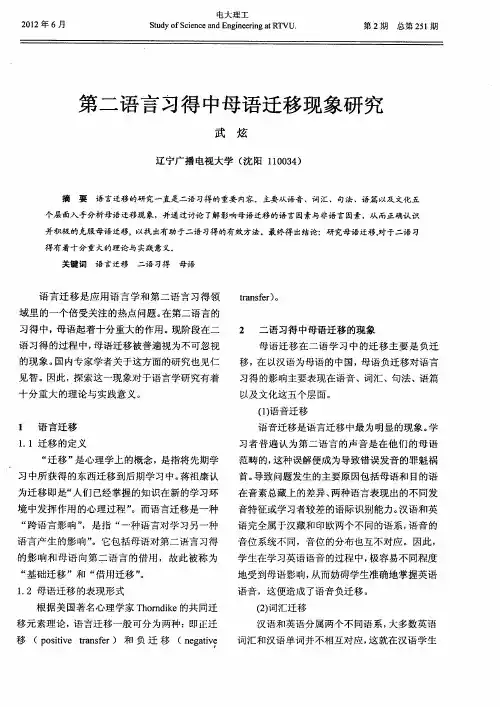
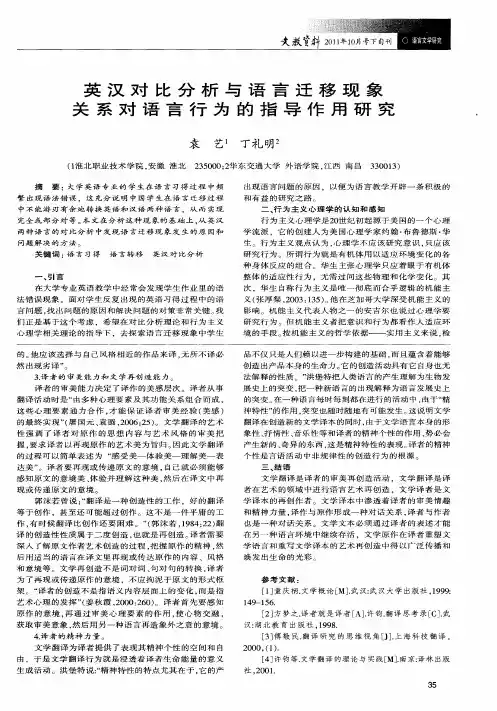
论述二语习得过程中的语言迁移现象1 语言迁移研究的发展与现状语言迁移是指语言学习者在学习的过程中,已经学习过的知识对新知识和技能的学习所产生的影响。
早期行为主义对迁移的研究要追溯到40年代和50年代,Fries的研究主张科学描述学习者的目的语,并且与其母语进行比较。
从而推动了语言学的对比分析研究。
50年代,行为主义心理学受到了挑战,认知语言学和普遍语法理论开始提出了“语言习得机制”和“普遍语法理论”,他们发现语言学习者总是会在母语与目的语两种语言间相似的地方出错,Corder还提出了“错误分析理论”,主张系统性地分析学习者在第二语言学习中所犯的错误。
Corder的《母语作用》中指出了负迁移的存在,他认为在第二语言学习的早期,迁移是起正作用的,当两种语言的语法结构有很大的差异时,学习者并没有母语迁移,而是求助于回避策略。
Kellerman的研究更进一层,他区别了学习者三种回避现象:目的语规则难于理解,特定情况下对目的语规则感到困难,学习者不愿意去表达。
他认为这是由于学习者与目的语文化之间的心理和社会距离造成的。
跨语言影响的研究主要是受到了认知语言学的推动,它以现代语言学和生成语法为理论框架,主要是对具有不同母语背景的学习者进行语言特性输出比较,从而寻找语言的规律,主要的著作有《语言学习中的语言迁移》、《迁移和干扰》、《输出中的迁移》、《语用迁移》等等,这些研究都是受到了行为主义、认知语言学、普遍语法的影响,并且又以认知语言学为基础进行的创新理论研究。
2 语言迁移的主要表现形式语言迁移强调学习者学习过程中产生的错误是传统语言迁移研究,研究者倾向于把迁移分为正负两种迁移,而且认为错误的产生是母语负迁移的结果。
但是经过众多学者的研究,语言迁移的表现形式有多种,主要可以分为以下几点。
2.1 正向迁移正向迁移就是由于母语和目的语之间有相同或者相似的语言规则,对学习产生了积极促进作用的迁移。
如果本族语和目的语之间的词汇规则相似,那么学习者在学习第二语言的过程中就会省时省力,而且效果会非常好,也就是说母语与第二语言之间的语法有相似的地方就会促进学习者的二语习得。
从心理语言学视角解读语言迁移现象一、引言“迁移”是一个心理学术语,指的是学习过程中学习者已有的知识或技能对新知识或新技能的获得的影响这一现象。
迁移理论主要的提出者是Skinner和Lado,他们认为在母语和要掌握的第二语言(即目标语)之间进行比较,找出二者的异同,这是很重要的,因为两种语言的相似可以促使从母语向第二语言的正迁移,而二者的不同则容易产生负迁移。
第一语言与第二语言的差异会导致第二语言的学习困难,而二者的相似性却有助于第二语言的习得。
然而,大部分语言迁移的研究旨在对二语和母语的语间差异进行解析和归类,以解决语言教学、学习中的实际迁移问题,而对其深层的内部形成机制缺乏探讨。
语言迁移的研究不能只停留在语言层面,更应探究其深层心理激发依据和形成原因,才能真正理解语言迁移现象,从而积极利用迁移在二语习得过程中的影响。
本文从语言心理学角度出发,简单介绍语言迁移对二语习得的影响,重点分析迁移过程中的心理活动和认知过程,并给出相关的切实可行的学习应对策略。
二、语言迁移及其理论发展语言迁移是指由于目标语与此前所习得的任何一种语言之间的异同,而对目标语学习产生的影响(OdlinT3)。
语言迁移一般分为两大类:正迁移,即目标语与母语(已习得语)之间的相似之处有利于目标语的学习;负迁移,即由于目标语与母语(已习得语)之间的差异干扰目标语的学习,语言迁移的影响体现在语音、词汇、语义、句法、语用、文化等多层面。
而在我国的特定语言环境中,语言迁移指的是学习者的母语——汉语在英语学习中的作用,即学生在英语学习过程中所受到得汉语习得经验的影响。
从语言习得的心理机制上看,从语言资料的输入、储存、转化和输出,母语能力以及生存环境赋予输入的母语思维模式和知识类型都在其中起着重要的作用。
这也使得学习者利用母语和母语思维学习目标语(英语)的学习策略成为一种必然。
语言迁移理论大致经历了三个发展阶段:最早可以追溯到20世纪40年代美国语言学家CharlesFries,RobertLado等人在对比分析假设模式框架下的研究,此时期的迁移研究受到了行为主义的影响,夸大了母语的干扰作用;70年代由于受乔姆斯基普遍语法观点的影响,基于对比分析假说的语言迁移理论受到质疑;而20世纪80年代以来,认知心理学视角的语言研究兴起,对迁移有了新的阐释:母语迁移不再被视作机械的行为迁移过程,而是语言学习中的一个重要策略,受到心理、社会、语言、认知等多层面的语言迁移。
英汉语篇反向语言迁移模式研究随着全球化进程的加速和各国语言和文化的交流,英汉语篇的反向语言迁移越来越引起学者们的关注。
反向语言迁移现象是指使用一种语言时对另一种语言的影响。
如今,很多中国人都会说英语,使用英语时不可避免地会用中文思维来影响其英语表达,这就是反向语言迁移现象的一个例子。
反向语言迁移既涉及到语言,也关系到文化。
因为语言和文化紧密相连,在使用另一种语言时,常常会用本国文化的理念来影响另一种语言的运用。
举个例子,中文中有“说了也是白说,不如做了让人家看看”的语言习惯,但是这种表达方式在英语中是不可取的,因为英语更注重表达的直接和简洁,如此表达就可以用“Actions speak louder than words.”来代替。
另外,反向语言迁移还与语境有关。
一个词汇或短语在使用中还要考虑其所处的语境,因为在不同的语境下,其意义也会产生不同的变化。
如在中文中,“水煮肉片”是一种特色菜,但如果直接翻译成英文,就成了“boiled meat slices in water”这样的表达,听起来就很不欣赏。
因此,适应用途的不同,语言运用方式也会随之而改变。
在反向语言迁移的研究中,一些学者提出了“两重基础”理论,即英汉语篇反向迁移涉及两种基础:一种是语言基础,另一种是文化基础。
在英汉语篇的交际中,文化基础可能更占主导地位,因为文化包含了语言所不能表达的一种“文化背景”,在跨文化交流中,文化因素对语言表达的影响因素更加重要。
因此,掌握不同语言及其文化背景对反向语言迁移至关重要。
除了要积累语言本身的词汇和语法知识外,还要了解该语言所处的文化环境,熟悉其习惯用语和常用表达方式,以达到更好的跨语言交流效果。
总之,英汉语篇反向语言迁移是跨文化交流中的一种现象,在语言和文化方面都具有一定的影响。
它的出现说明了语言和文化之间的紧密联系,也为我们进行跨语言交流提供了新的思路和方向。
语言迁移的研究历史、成因及研究意义近年来,概念迁移理论日益成为国内外语言迁移研究领域的关注热点并已取得一定的发展。
概念迁移理论不同于以往的语言迁移理论,它是从概念层面研究语言习得中的语言迁移现象。
Ogden 和Richards 在其《意义的意义》一书中指出,一个语言符号和它所指的具体事物之间没有直接联系,而是以概念作为中介,当学习者学习一门新的语言时,或多或少都会将对母语概念系统的理解向外语学习中迁移。
本文拟通过对概念迁移理论的研究分析,旨在探讨语言学习者在学习过程中的语言迁移现象,从而推动外语教学研究,帮助学习者更有效的学习语言。
一、语言迁移的研究历史二十世纪50年代,二语习得领域引入了母语影响的概念,语言迁移理论逐渐走入人们的视野,研究此理论的早期语言学家是Robert Lado.受Lado 等学者的影响,对比分析假设理论逐渐形成,到了二十世纪70年代,受乔姆斯基转换生成语法和普遍语法的影响,学者们逐渐对对比分析假设产生了质疑,Selinker(1972)提出了中介语理论,90 年代以来迁移研究逐渐超越语言知识层面,开始探索其认知基础。
一直以来,虽然有一些学者也曾经从概念层次探讨语言现象,但从这一视角出发的研究真正开始是以概念迁移术语的正式提出为标志。
1998 年,宾夕法尼亚洲Temple 大学的Pavlenko 在其论文中,首次使用了概念迁移(Conceptual transfer)这一术语,同年,美国Ohio 大学语言学主任Scott H. Jarvis 出版了Conceptual Transfer in the InterlingualLexicon 一书,Conceptual Transfer这一术语首次出现在研究语言迁移的专着中[7].2008 年,Jarvis 和Pavlenko 合着的《语言与认知中的语际影响》一书对当前概念迁移研究的新动态进行了总结回顾与思考。
他们认为每种迁移现象都可以从十个不同的角度进行理解,分别是语言使用的领域、方向性、认知层级、知识种类、意向性、模式、渠道、形式、表现和结果十个角度。
成绩西南大学本科生课程论文论文题目:The Influence of LanguageTransfer to English Study课程名称:第二语言习得任课教师:林文治专业:英语师范班级:英师1014学号:罗雪梅姓名:2220103100114022013年12月4日西南大学外国语学院制Abstract: Language transfer has a great influence to learning English for Chinese students . This paper focus on the influence of positive transfer and negative transfer between English and Chinese by analyzing three aspects: sound, vocabulary and grammar. The purpose of the paper is to promote the positive transfer and conquer the negative transfer on the basis of analogical analysis, and finally improve English learning.Key words: language transfer; positive transfer; negative transfer; English learning1.Introduction1.1 Definition of language transferThe origins of the term “transfer”go back to Behaviorism and its view is that the mother tongue habits influence learning of the foreign language habits. Although it was later discredited, the notion of transfer has been revived again and remains one of the most fundamental in foreign language acquisition research. Transfer in terminology of foreign language research has been giving rise to much controversy. Odlin(2001) assumed that transfer is not 1) A consequence of habit form action; 2) Interference; 3) A falling back on the mother tongue. And transfer is not always mother tongue influence. He offers the working of substratum transfer as a basis for his own thoughtful treatment of such influence: transfer is the influence resulting from similarities and differences between one language and any other language that has been previously (and perhaps imperfectly) acquired. This working definition, although somewhat vague, provides an adequate basis for the materials to be deserved discussion.Language transfer is also called cross linguistic influence. Kellerman and Sharwood(1986) argued that a superordinate term that is theory-neutral is needed and suggest cross linguistic influence. And it is one of the key factors contributing to the learner’s interlanguage. According to Odlin(1989) , transfer is the influence resulting from similarities and differences between the target language and any other language that has been previously acquired. Krashen(1983) views transfer as padding, the result of falling back on old knowledge when new knowledge is lacking. Corder(1983) holds that transfer is primarily a communication strategy, or borrowing, which is a performance phenomenon, not a learning process. Jarvis(2000) identifies three criterion for identifying transfer (1) inter-group homogeneity, (2)inter-group heterogeneity and (3)similarities between the native language and inter-language performance.1.2 Classification of language transferThe notion of transfer as above- mentioned is closed related to the behaviorist theories and in 1950’s Lado introduced this term into the field of second language learning. They assume that learners tend to transfer the characteristics of their native languages and cultures into the foreign languages and cultures that they are learning. Therefore, the learning of a second language was seen as rather an increase of a behavioral repertoire. Learning another language is in fact learning a set of alternatives for some sub-set of the rules of the language they already know. Accordingly, similarities between L1 and L2 are believed to facilitate the learning of L2. Facilitation of this kind is called positive transfer. However, the other type is negative transfer which is regarded as the cause to errors for learners when they learn a foreign language. Negative transfer means that the differences between L1 and L2 cause learning difficulty and result in making errors. Selinker once said that the errors were the result of the interference frommother tongue. Negative transfer is considered to be responsible for error occurrences in foreign language learning. Then, Richards ( 2000 ) evidenced that negative transfer of strategies was but partially responsible for the learners' errors. Since then, it seems that negative transfer shall be avoided no matter in learning or in teaching.1.3 Three periods of language transferGenerally, the study of language transfer has experienced three periods: behaviorist, mentalist and cognitive period. In the 1950s, transfer in behaviorist accounts was seen as a impediment. In the late 1960s, under the influence of Chomsky’s Universal Grammar, its importance waned while learner’s errors were seen not as evidence of language transfer but rather of “the creative construction process”. Some researchers virtually denied the existence of transfer. From 1970s, a more balanced perspective has emerged in which the role of transfer is acknowledged. Mother’s tongue’s transfer in English language teaching has been emphasized and studied since then. But there are two distinctive opinions. Some linguistic researchers hold that there is unnecessary to use mother tongue in English teaching in order to reduce the errors that caused by mother tongue negative transfer while others argue that mother tongue in English language teaching is helpful to learners in English language mastering. Two studies of relative clauses illustrate how transfer can have a facilitative effect by Gass and Selinker (1983). In this paper, the author agree to the later opinion. Mother tongue in English language teaching is beneficial if teachers could help students promote positive transfer and conquer negative transfer.nguage Transfer in English LearningIn practice, attention is almost exclusively directed to the differences of L1 and L2 today because negative transfer is more noticeable than positive transfer. The positive transfer is ignored by many linguists. But the truth is there are many similarities between the two languages. It is easy to find that a person who can speak English fluently must speak Chinese well. The similarities can stimulate the positive transfer from L1 to L2. 2.1 Positive transfer in English learningGenerally speaking, the more similarities there are between two languages, the more possibilities of positive transfer happen. Similarities between English and Chinese do exist in speech sound, vocabulary and grammar. So it is possible and helpful to make use of those similarities to facilitate our English teaching and promote students learning.2.1.1 Positive transfer in speech soundsChinese students have no difficulty in pronouncing phonemes like /p/, /b/, /t/, /d/, /g/, /k/, /h/ and /f/ as we have sounds in Chinese which are articulate almost in the same manner: b, p, d, t, g, k, h, f.2.1.2 Positive transfer in vocabularyChinese and English have the same word-formation: compound. For example, the English word “goldfish” and Chinese word “金鱼” have the same meaning and same structure. They are both consisted of the same structure: adjective of color+object.2.1.3 Positive transfer in grammarA lot of grammar similarities between English and Chinese make it possible for students to transfer positively some Chinese features into learning English. For example, the following five basic English sentence patterns are almost structurally the same as the Chinese sentences.(1) S+link-v+Predicative.I am a student.我是一名学生。